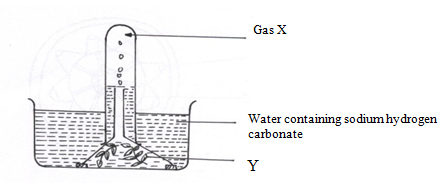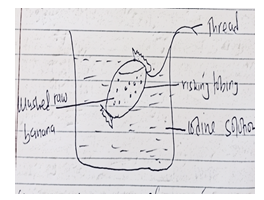SECTION A (40 MARKS)
Answer all questions in this section
- A cross between a red flowered plants and white flowered plants produced plants with pink flowers. Using letter R to represent the gene for red color and W for white.
- What were the parental genotypes? (2mks)
- Work out the cross between f1 generations (4mks)
- State the phenotypic and genotypic ratios of the f2 generations (2mks)
- The set up shown was used to investigate a certain process. The set up was left in bright sunlight for 4 hours.
- State the aim of experiment (1mk)
- Name X and Y (2mks)
- Other than sunlight name three factors that would affect the experiment (3mks
- State how the identity of gas X could be confirmed (1mk)
- Explain why submerged water plants was used in the experiment (1mk)
-
- What is meant by:
- Autecology (1mk)
- Synecology (1mk)
- Using the table below, answer the questions that follow
Number of stomata
Leaf
Upper epidermis
Lower epidermis
A
300
0
B
150
200
C
02
13
Suggest the possible habitat of the plants from the leaves were obtained (3mks)
A
B
C - State the modifications in the stomata of leaf C (3mks)
- What is meant by:
- In an investigation, a raw banana was peeled, mashed into a paste and treated as shown in the set up below.
- Name the physiological process being investigated (1mk)
- State the expected observations in the above set up after 30 minutes (2mks)
- Account for the observations made in (b) above. (2mks)
- State three role of active transport in human (3mks)
-
substance
% in blood Plasma
% in glomerular
Filtrate
% in urine
Water
Protein
Urea
glucose
100
6.5
0.03
0.1
90
0
0.03
0.1
60
0
1.8
0
- Why is the concentration of protein in glomerular filtrate and urine zero? (1mk)
-
- By how many times is urea more concentrated in urine than in glomerular Filtrate? (1mk)
- Explain why there is greater concentration of urea in urine than glomerular filtrate (1mk)
- Explain why there is no glucose in urine (1mk)
- State the economic importance of the following plant excretory products
- Rubber (1mk)
- Papain (1mk)
- State two reasons why plants lack complex excretory organs. (2mks)
SECTION B: (40MARKS)
Answer question 6 (compulsory) and either question 7 or 8 in the spaces provided.
- During germination and growth of cereal, the dry weight of the endosperm, the weight of the embryo and the total dry weight were determined at two days intervals. The results are shown in the table below.
Time after planting (days)
Dry weight of endosperm (mg)
Weight of embryo (mg)
Total dry weight (mg)
0
2
4
6
8
10
43
40
33
20
10
6
2
2
7
16
25
33
45
42
40
37
35
39
- On the same axes, plot a graph of dry weight of endosperm, weight of the embryo and the total dry weight against time. (8mks)
- What was the total dry weight on day 5? (1mk)
- Account for the;
- Decrease in dry weight of the endosperm from day 0 to 10 (2 mks)
- Increase in weight of the embryo from day 0 to 10 (2mks)
- Decrease in the total dry weight from day 0 to 8 (1mk)
- Increase in the total dry weight after day 8 (1mk)
- State two factors within the seed and two outside the seed that cause dormancy. Inside seed
- Inside seed (2mks)
- Outside seed (2mks)
- Give one characteristic of meristematic cells (1mks)
-
- Describe the process of fertilization in flowering plants (15mks)
- State five adaptive features of red blood cells to their function (5mks)
-
- Explain inspiration in the gills of bony fish (10mks)
- Explain the factors affecting the rate of breathing in humans (10mks)

MARKING SCHEME
-
- RR; WW;
- Phenotypic ratio 1 Red flowered: 2 Pink flowered: 1 white flowered; Rej: 1:2:1
Genotypic ratio 1RR: 2RW:1WW; Rej: 1:2:1
-
- To investigate gas produced during photosynthesis;
- X-Oxygen gas;
Y-Elodea/ water plant; -
- Carbon (IV) oxide;
- Temperature;
- Water availability;
- Availability of mineral salts;
- the gas rekindles/ relights a glowing splint;
- water plant is adapted to live in water environment and will also generate more oxygen gas;
-
- Autecology-study of a single species;
Synecology-study of many species; - A- aquatic/ fresh water;
B-terestrial/ forest;
C-arid/ semi-arid/ desert; -
- Sunken stomata;
- Reversed stomatal rhythm;
- Mid-day closure;
- Small stomatal pore;
- Autecology-study of a single species;
-
- Diffusion;
- Inside the visking – colour turns blue black while iodine in the beaker remains brown/ no colour change/iodine retains its brown colour;
- Iodine molecules are smaller in size than starch molecules; iodine molecules diffused through the visking tubing and reacted with starch molecules;
-
- Reabsorption of mineral salts/ sodium ions in the kidney tubules;
- Reabsorption of glucose molecules from kidney tubules;
- Movement of waste products from blood cells into blood;
-
- Proteins are not part of the glomerular filtrate as they are too large (have large molecular sizes) to pass through the small pores of the walls of glomerular;
-
- 1.8/0.03=60 times
- As the filtrate flows in the tubules, water gets reabsorbed and not urea. This causes the concentration of urea to rise;
- Glucose is completely reabsorbed at the proximal convoluted tubule;
-
- -Rubber-used in shoe and tyre industry;
-manufacture of chewing gums; (max-1mk) - -Papain-used as meat tenderizer;
-Management of arthritis; (max-1mk)
- -Rubber-used in shoe and tyre industry;
-
- produces fewer and simple types of wastes products because they are autotrophic;
- plants wastes are produced in very small quantities due to plants low rate of activity;
- some organic waste products are stored in some i.e. leaves, flowers, fruits and bark which are removed when those organs are shed;
- excess amino acids are used to synthesize protein which can be stored unlike animals;
- plants can recycle their wastes;
- plants can store their wastes in non-toxic forms; (max-2mks)
SECTION B
-
- Axis(A)
Scales (s)
Plotting
Curve
Identity (curves) - 5mg + 0.5
-
- There was hydrolysis of starch into simple sugar; which was used for respiration to provide energy for growing embryo;
- Raw materials are synthesized and protoplasm produces new tissues; bringing about growth of embryo;
- The rate of respiration was higher than that of synthesis of materials for growth in the embryo;
- First leaves started carrying out photosynthesis thus increasing protoplasm;
- Factors within seed
- Impermeable seed coat;
- Presence of abscisic acid (ABA) Germination inhibitors;
- Embryo not fully developed;
- Absence of hormone/enzyme that stimulates germination; (mark first two (2mks)
Factors outside seed - Unfavorable temperature;
- Absence of light;
- Lack of oxygen;
- Lack of water; (Mark first two (2mks)
-
- Have dense cytoplasm;
- They are small;
- Have thin cell walls;
- They do not have sap vacuole;
- Do not have chloroplast;
(Mark first 1 = 1mk)
- Axis(A)
-
-
- Fertilization is the fusion of male and female nuclei in the embryo sac; the male gamete is contained in the pollen grain; produced in the anthers; the female gamete is found in ovules; within the embryo sac; after pollination, the pollen grains absorb nutrients from the stigma; and develops an outgrowth called pollen tube; which grows down the style to the embryo sac taking along the male gametes with it; the pollen grains usually adhere/ stick to the stigma as a result the stigma cells secreting a sticky substance; which also stimulates pollen grains to germinate, sending down its pollen tube; the growth of the pollen tube into the stigma through the style to the ovary, is by pushing its way between the cells where it gets its nourishment from the surrounding tissue;
- As the pollen grain germinates; the tube nucleus occupies a position at the tip of the growing pollen tube; the generative nucleus divides by mitosis; into two male gamete nuclei; which follow behind the tube nucleus as the pollen tube grows down the style. The pollen tube enters an ovule through the micropyle; and when it reaches the centre of the ovule, it penetrates the wall of the embryo sac and burst open; the tube nucleus disintegrate leaving a clear way for the entry of two male nuclei; one of the nuclei fuse with egg nucleus; to form diploid zygote; which develops into an embryo; while the other male nucleus fuses with the polar nucleus to form a triploid nucleus; this gives the double fertilization in flowering plant; (Total marks 22 max 15)
-
- have biconcave shape that creates a large surface area for diffusion of gases;
- contain haemoglobin which readily combine with oxygen;
- lack nucleus and other organelles which allow more space for packing of haemoglobin;
- have thin plasma membrane which allows rapid diffusion of gases;
- small and numerous which offer a large surface area for diffusion of gases;
- have enzyme carbonic anhydrase which enables them to transport (carbon (IV)oxide);
- are (flexible/adaptable to change) enables them to move through capillaries;
-
-
- Explain inspiration in the gills of bony fish
- Mouth opens;
- Muscular contractions in the mouth lowers the floor the of the mouth;
- This increases volume in mouth cavity and decreases the pressure inside it;
- The water outside is at a higher pressure and it rushes in through the open mouth;
- Each operculum on the side of the fish bulges outwards by muscular action;
- This increases volume and lowers pressure in the operculum cavity;
- Water containing dissolved oxygen from the mouth is sucked into the gill chamber over the gills;
- Oxygen diffuses into the blood capillaries; due to oxygen diffusion gradient;
- Explain factors affecting the rate of breathing in human beings
- Exercise;
During vigorous physical activity the rate of breathing increases so as to meet the increased demand of oxygen;
Faster breathing also eliminates the extra carbon (IV) oxide produced by the increased respiration; - Age;
Young people have a higher demand of oxygen. They therefore have faster breathing rate; this is because young people are actively growing hence the faster rate of breathing is to supply tissues with oxygen; - Emotions;
Generally the body emotions affect the production of hormone adrenaline which increases the general metabolism and hence increased rate of breathing; e.g. fear anxiety and fright; - Temperature;
When the temperature is high; there is a tendency in the rate of gashouse exchange to increase. However if temperature is too high the breathing rate will reduce; - Health
During sickness the rate of breathing increases. The faster rate of breathing enables the liver to remove toxins in drugs those released by diseases causing micro-organism;
The faster rate of breathing also enables the kidneys to excrete waste products of body metabolism through urine;
- Exercise;
- Explain inspiration in the gills of bony fish
Download BIOLOGY PAPER 2 - KCSE 2019 STAREHE PRE MOCK EXAMINATION (WITH MARKING SCHEME).
Tap Here to Download for 50/-
Get on WhatsApp for 50/-
Why download?
- ✔ To read offline at any time.
- ✔ To Print at your convenience
- ✔ Share Easily with Friends / Students



